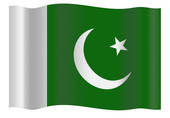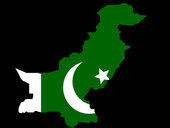BACKGROUND TO PARTITION
The concept of a separate Muslim "nation" or "people," qaum, is inherent in Islam, but this concept bears no resemblance to a territorial entity. The proposal for a Muslim state in India was first enunciated in 1930 by the poet-philosopher Muhammad Iqbal, who suggested that the four northwestern provinces (Sindh, Balochistan, Punjab, and the North-West Frontier Province) should be joined in such a state. In a 1933 pamphlet Choudhary Rahmat Ali, a Cambridge student, coined the name Pakstan (later Pakistan), on behalf of those Muslims living in Punjab, Afghan (North-West Frontier Province), Kashmir, Sind, and Balochistan. Alternatively the name was said to mean "Land of the Pure." (H.R.T.)
ISLAMIC REPUBLIC OF PAKISTAN
- Mohammed Ali Jinnah died in September 1948, within 13 months of independence. The leaders of the new Pakistan were mainly lawyers with a strong commitment to parliamentary government. They had supported Jinnah in his struggle against the Congress not so much because they desired an Islamic state but because they had come to regard the Congress as synonymous with Hindu domination. They had various degrees of personal commitment to Islam. To some it represented an ethic that might (or might not) be the basis of personal behaviour within a modern, democratic state. To others it represented a tradition, the framework within which their forefathers had ruled India. But there were also groups that subscribed to Islam as a total way of life, and these people were said to wish to establish Pakistan as a theocracy (a term they repudiated). The members of the old Constituent Assembly, elected at the end of 1945, assembled at Karachi, the new capital.
Jinnah's lieutenant, Liaquat Ali Khan, inherited the task of drafting a constitution. Himself a moderate (he had entered politics via a landlord party), he subscribed to the parliamentary, democratic, secular state. But he was conscious that he possessed no local or regional power base. He was a muhajir ("refugee") from the United Provinces, the Indian heartland, whereas most of his colleagues and potential rivals drew support from their own people in Punjab or Bengal. Liaquat Ali Khan therefore deemed it necessary to gain the support of the religious spokesmen (the mullahs or, more properly, the ulama). He issued a resolution on the aims and objectives of the constitution, which began, "Sovereignty over the entire universe belongs to Allah Almighty alone" and went on to emphasize Islamic values. Hindu members of the old Constituent Assembly protested; Islamic states had traditionally distinguished between the Muslims, as full citizens, and dhimmis, nonbelievers who were denied certain rights and saddled with certain additional obligations.
PAKISTAN ARMY
PAKISTAN HAS GOT A BRAVE ARMY .PAKISTAN IS NUCLEAR POWER COUNTRY(PAKISTAN HAS GOT A NUCLEAR BOMB
THIS IS THE VIDEO OF THE NUCLEAR TEST IN PAKISTAN
THE FLAG OF PAKISTAN

THIS IS PAKISTANI FLAG IT HAS TWO COLOURS WHITE AND GREEN .THE PAKISTANI FLAG WAS DESIGNED BY SYED AMIR-UDDIN KEDWAII . THE WHITE PART OF FLAG SHOWS NON MUSLIMS AND GREEN PART SHOWS MUSLIMS THATS MEAN IN PAKISTAN THERE IS 70% MUSLIMS AND 30% OF NON MUSLIMS
THE MAP OF PAKISTAN

THIS IS THE MAP OF PAKISTAN
